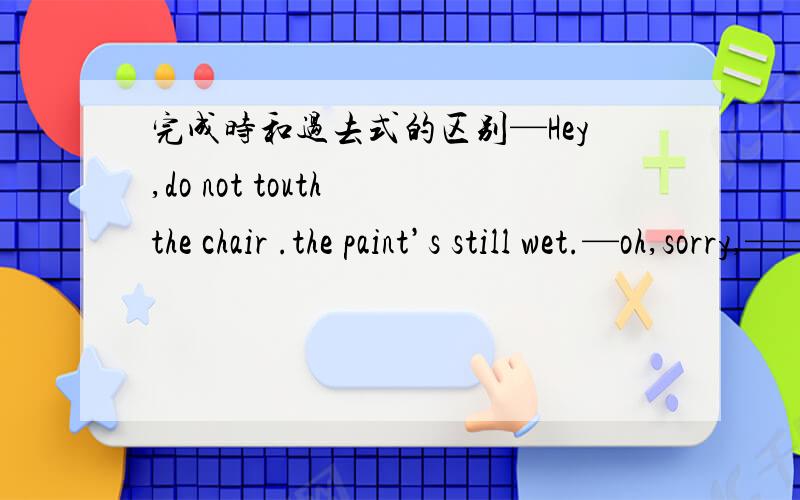完成时和过去式的区别—Hey,do not touth the chair .the paint’s still wet.—oh,sorry,——that.A.i am not seeing B.i have not seen C.i do not see D.i did not see选择D,我想知道为什么不是B.我希望能够以后碰到这类题,
来源:学生作业帮助网 编辑:作业帮 时间:2024/04/28 03:11:41

完成时和过去式的区别—Hey,do not touth the chair .the paint’s still wet.—oh,sorry,——that.A.i am not seeing B.i have not seen C.i do not see D.i did not see选择D,我想知道为什么不是B.我希望能够以后碰到这类题,
完成时和过去式的区别
—Hey,do not touth the chair .the paint’s still wet.
—oh,sorry,——that.
A.i am not seeing B.i have not seen C.i do not see D.i did not see
选择D,我想知道为什么不是B.我希望能够以后碰到这类题,都能解决.
完成时和过去式的区别—Hey,do not touth the chair .the paint’s still wet.—oh,sorry,——that.A.i am not seeing B.i have not seen C.i do not see D.i did not see选择D,我想知道为什么不是B.我希望能够以后碰到这类题,
D.i did not see
就是指过去没注意的事实
B.i have not seen
完成时更强调表示动作发生在过去,对现在造成了影响或产生了结果.
所以,B强调你注意了什么
而非你是否注意
看看以下的几组句子,有什么区别?
① Have you seen the film?(A)
Did you see the film?(B)
[说明] 你看过这部电影吗?(A)句强调的是被问者对剧情是否了解;(B)句强调的是看这部电影的动作是否发生过,并不强调是否知道其内容.
② How has he done it?(A)
How did he do it?(B)
[说明]他是怎么做的这件事?(A)句强调的是他做这件事的方式对现在产生了某种影响;(B)句单纯的
询问做这件事的方式.
③ He has lived in Beijing for 8 years.(A)
He lived in Beijing for 8 years.(B)
[说明]他在北京住了8年.(A)句讲的是到目前为止他在北京住了8年,可能还会继续在北京住下去.(B)句讲的是他在北京住过8年,现在不在北京了.
http://zhidao.baidu.com/question/7318043.html?fr=qrl3
answer is D
完成时的目的是指:某动作的结果对说话所产生的影响.
而过去时:则就指说话以前的事,与说话时无关.
选D刚才没看见,选B就是刚才没看见现在也没看见。